Thai Yellow Chicken Curry with Potatoes is a surprisingly easy but super flavorful recipe that you can make at home. Simply combine yellow curry paste with chicken, potatoes, carrots, onions, and coconut milk and simmer away. This is one of the best healthy dinners that’s SO much better than takeout!
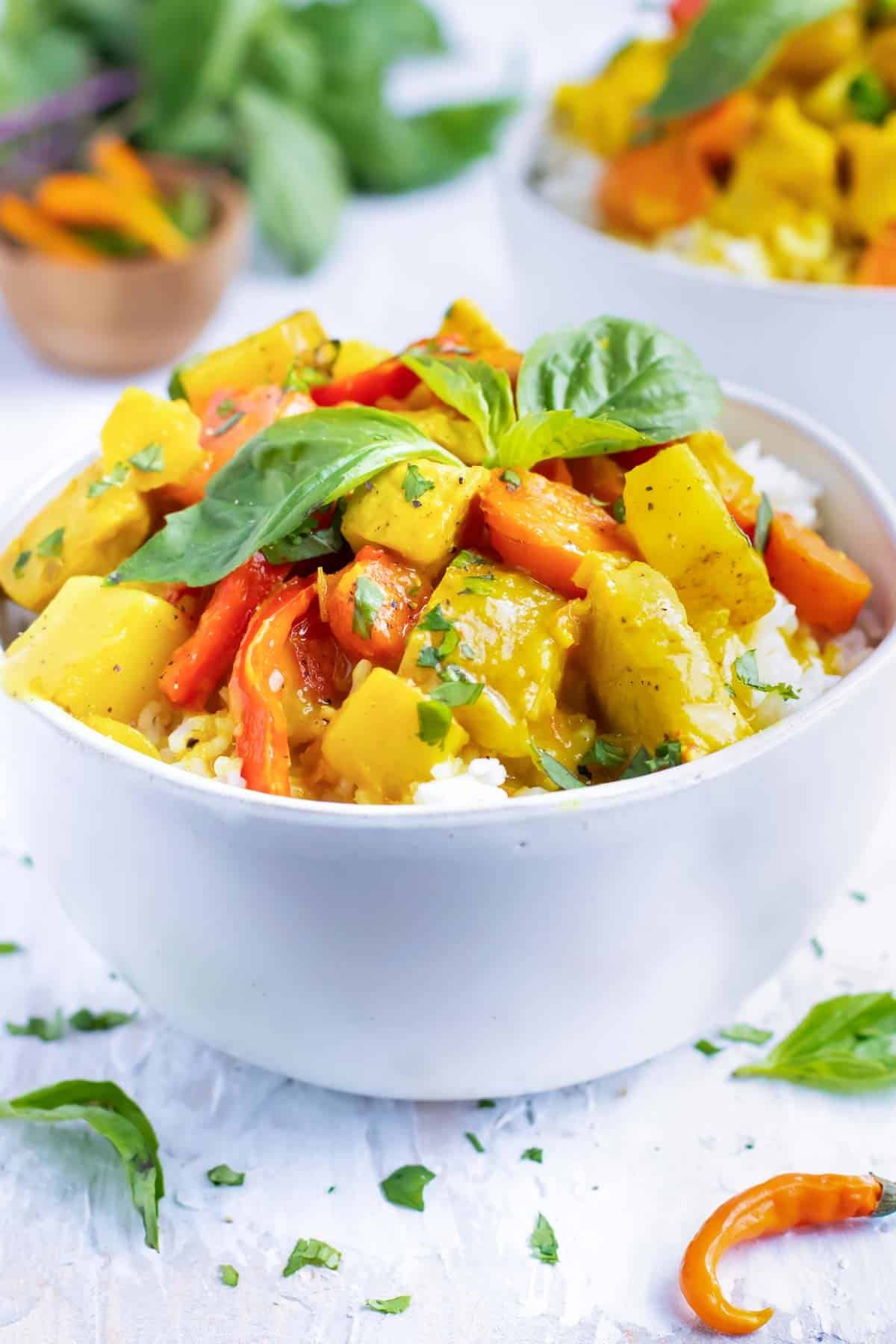
Best Thai Yellow Curry Recipe
I used to live near an inconspicuous yet amazingly authentic Thai place. It is probably my favorite Thai restaurant.
I simply loved their Thai yellow chicken curry. No matter how much I ate there, I never got tired of the rich flavor and creamy sauce that warmed me from the inside out.
After some time enjoying this dish a little too often, I realized that I had a true fear… a fear of attempting and ultimately failing at executing a foreign cuisine’s classic recipe.
But it’s surprisingly easy to make, and SO delicious. You can keep it simple by buying a Thai yellow curry paste at the store or make your own at home! (And make all kinds of Thai curries…)
Now that I’ve done the legwork, I can honestly say this homemade curry is incredible. I don’t feel the need to eat out quite so often. If it’s your first time making Thai food, don’t fear! You’ll be digging into a delicious bowl in no time.
Table of Contents
What is Yellow Curry?
Yellow curry is a milder curry that is often served at Thai restaurants in the West. It is made from a paste full of numerous spices such as curry powder, coriander, turmeric, ginger, garlic, peppers, lemongrass, and sometimes a touch of sugar is added. It is then cooked together with coconut milk to make a delicious yellow curry sauce.
Most yellow curries are made with either chicken, beef, or fish. Then starchy vegetables, such as potatoes, are added. It is served over steamed rice or with rice noodles.
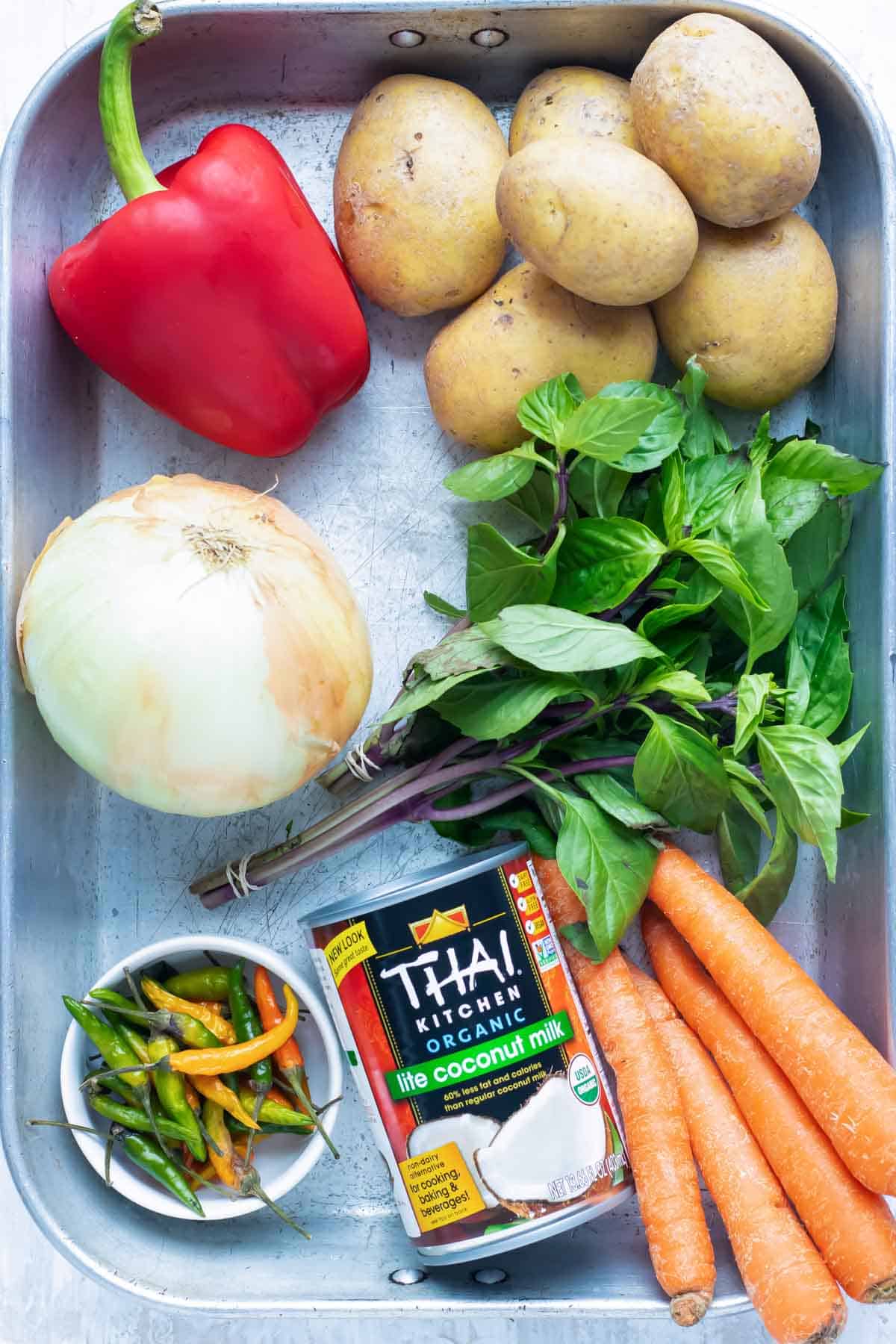
Ingredients
- Chicken. Both chicken breasts and boneless chicken thighs will work equally as well. Just make sure you cut it into similarly-sized cubes so they cook at the same rate. You can also substitute beef or shrimp and adjust the cooking time accordingly.
- Potatoes. Yukon gold are a great variety to use in this curry recipe. However, if you happen to have red potatoes or another waxy potato available, feel free to use those instead.
- Carrots. These give the dish a nice texture and a natural sweetness.
- Red Bell Peppers. You can also use a green or yellow bell pepper.
- Coconut Milk. Make sure you buy the CANNED coconut milk, not the kind in the refrigerator. Also, if you want a thicker curry, opt for full fat coconut milk. If you are okay with it being a bit more watery, but with fewer calories, lite coconut milk works great!
- Yellow Curry Paste. You can easily grab a jar of yellow curry paste at local grocery stores. Or, make your own curry paste! All you need is fresh garlic and ginger, Thai chili peppers, lemongrass paste, and spices (salt, turmeric, curry powder, and coriander). Check a local Asian market, if needed.
How to Make Thai Yellow Curry
Please see the recipe card below for more detailed ingredient amounts.
1. (Optional) Make the Yellow Curry Paste
You can either use a store-bought or make your own Thai yellow curry paste at home! If making at home, you’ll want to follow these steps:
Add the garlic, ginger, diced Thai chili peppers, salt, turmeric, curry powder, coriander, and lemongrass paste to a food processor or high-speed blender. Process until a smooth paste forms.
You especially want to be sure the peppers are fully blended to best distribute their flavor throughout the curry.
You can store this fragrant paste for up to 2 weeks in an airtight zip-top bag in the refrigerator for the best flavor. If you keep it much longer it will most likely start to lose its potency!
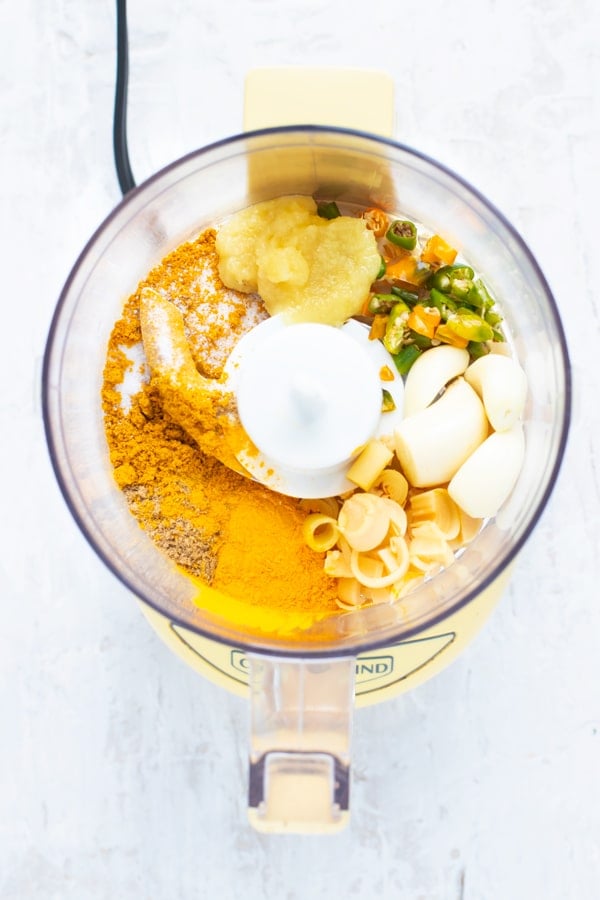
2. Prep the Vegetables and Chicken
Use a sharp knife and a cutting board.
Chop the potatoes, red pepper, carrots, and onions into small, bite-sized pieces.
Slice the chicken into 1-inch cubes, as well. Remember, keep everything as similarly sized as possible so it cooks at the same rate.
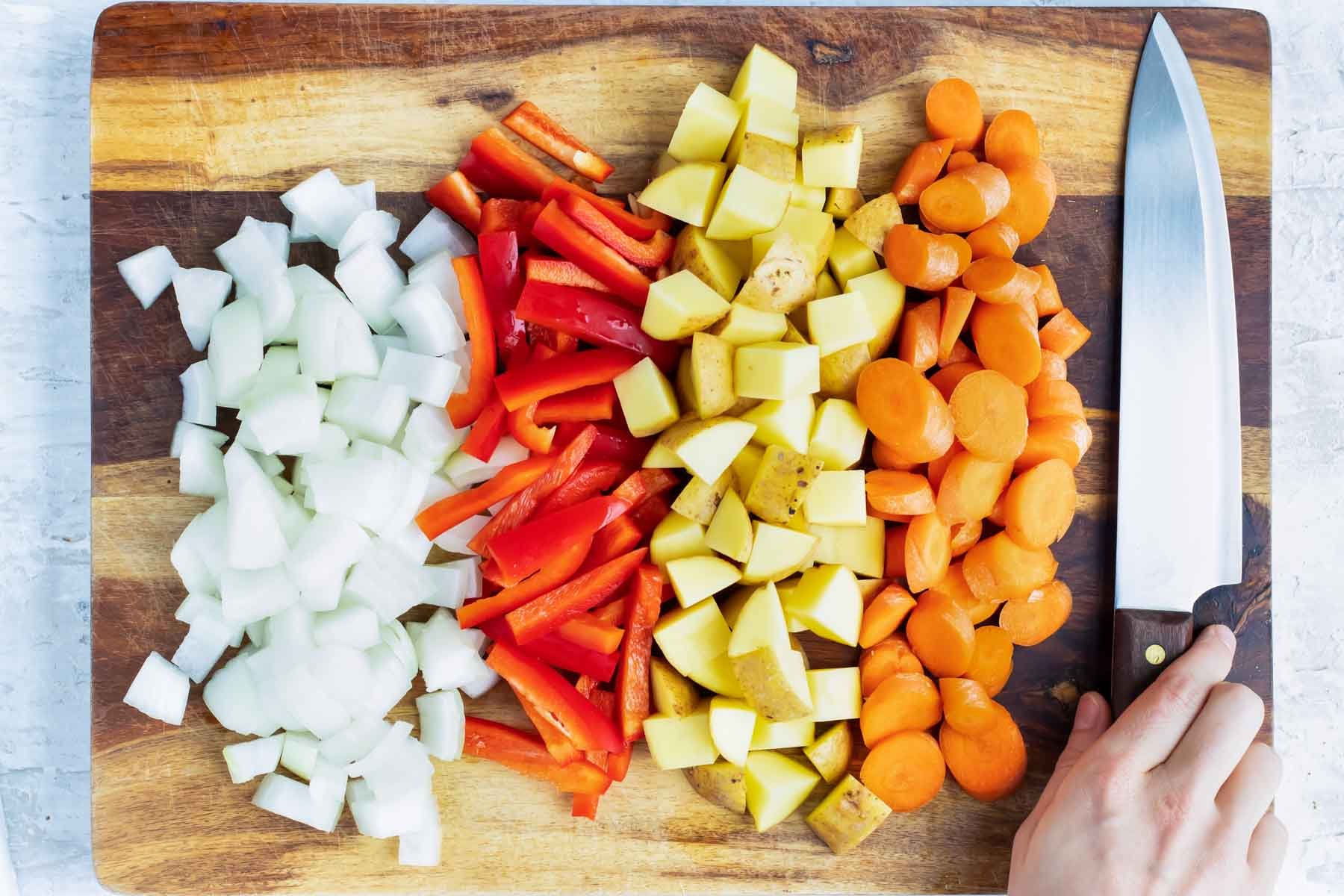
3. Make the Curry Sauce
Add the oil to a large skillet over medium heat. Sauté the onions in olive oil until translucent, then add the chicken breast.
Cook the chicken until it’s almost cooked through. Add the coconut milk, yellow curry paste, bell pepper, potatoes, and carrots. Stir it all together.
Simmer the yellow curry sauce for 25-35 minutes, or until you have tender chicken and vegetables.
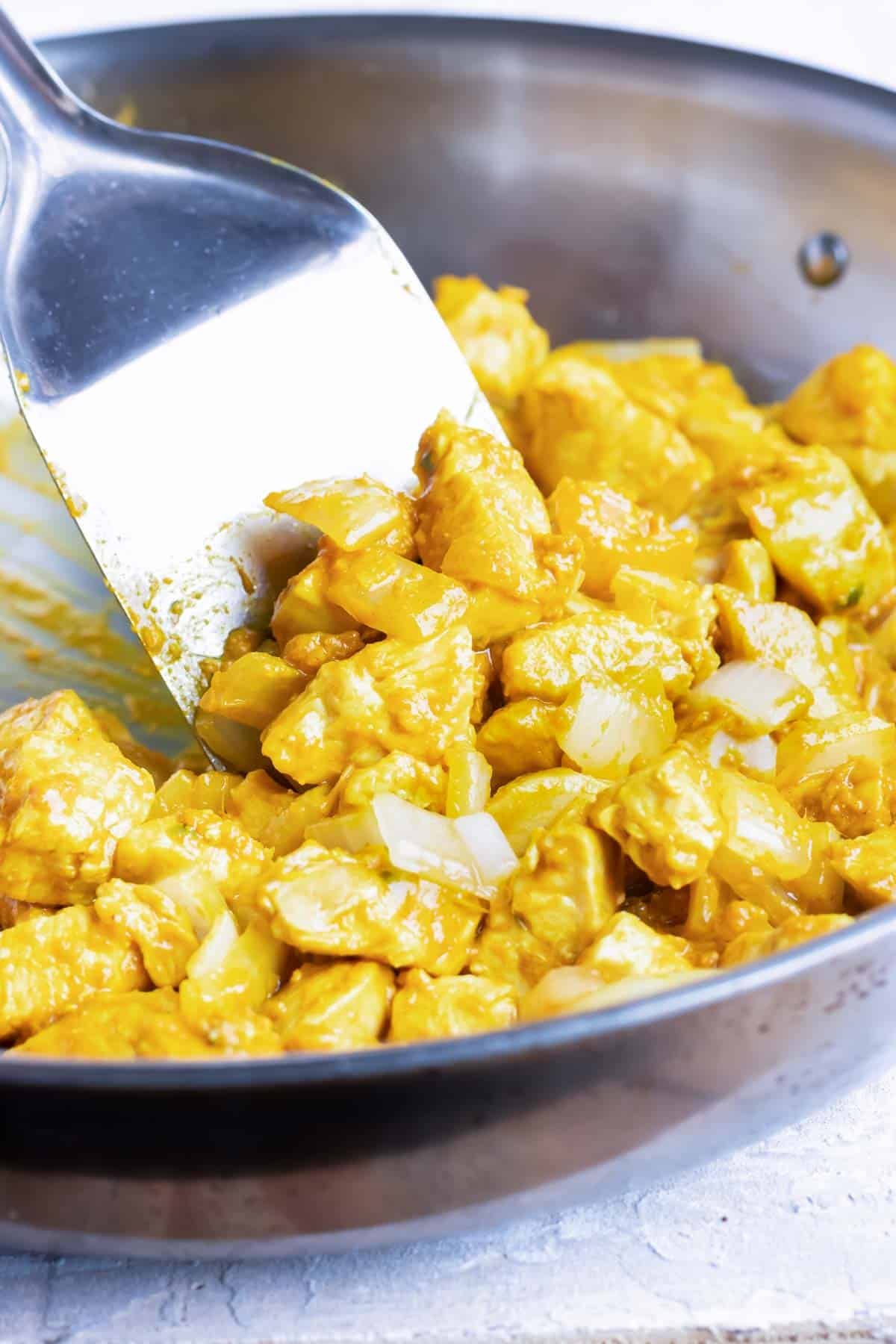
4. Serve the Curry
Serve Thai curry over your favorite rice and garnish with Thai basil if you’d like.
These rice recipes will all work great with this dish:
- Instant Pot White Rice
- Cauliflower Rice
- Instant Pot Basmati Rice
- Coconut Cilantro Brown Rice
- Jasmine Rice
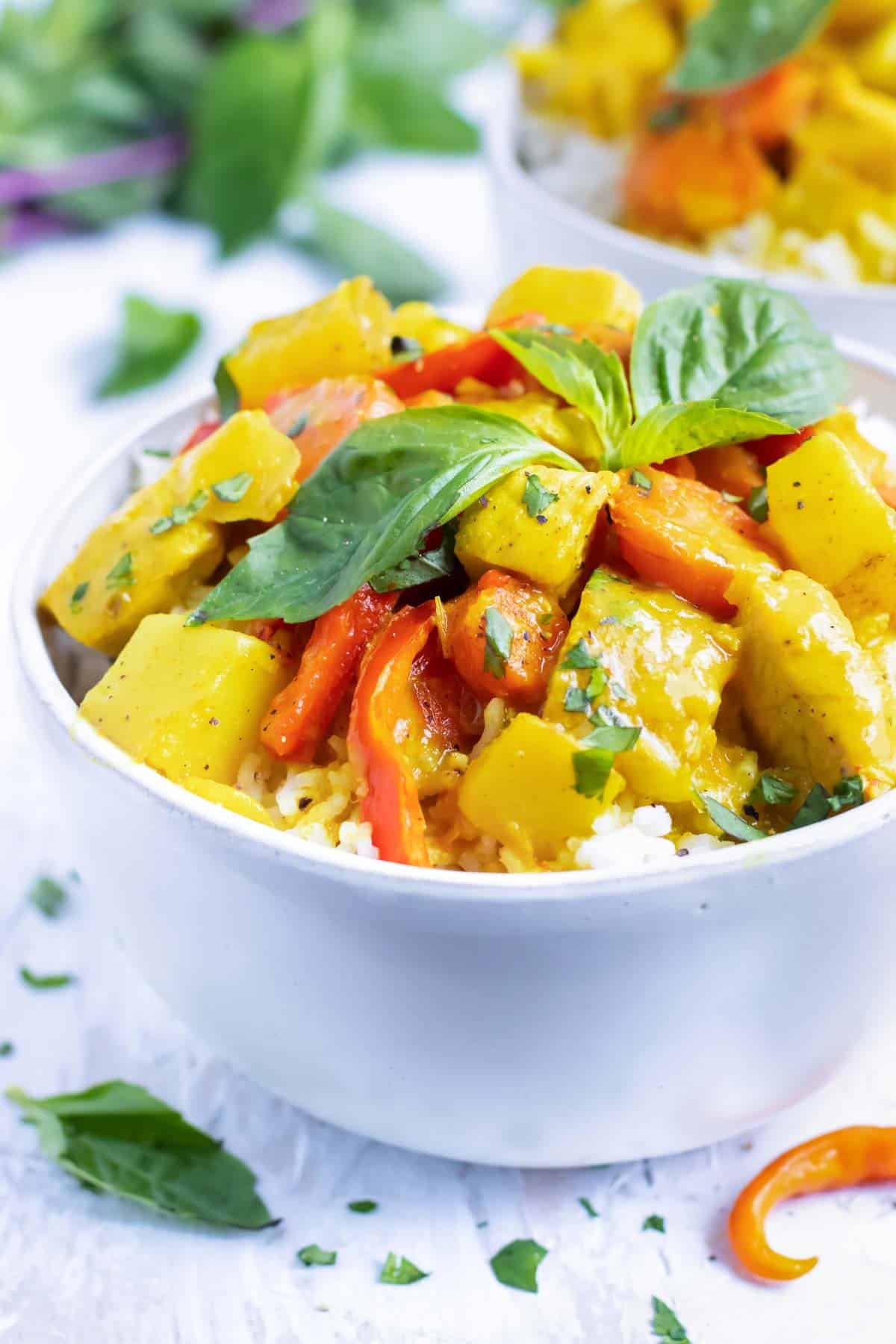
FAQs
Thai yellow curries are a flavorful blend of garlic, ginger, and Thai peppers along with spices like turmeric, curry, coriander, and lemongrass paste, typically. These flavors simmer together with coconut milk, a protein like chicken, and tender vegetables like potatoes and carrots. It’s on the milder end of the spice scale and has the perfect amount of heat for those just starting out in curries.
Thai yellow curry is from Thailand. Many times, people confuse this dish with Indian curries. However, curries from Thailand usually rely on a different set of herbs and aromatic leaves, while Indian curries have more spices.
Thai yellow curry is a delightfully earthy mix of spices and herbs. It is typically milder than red or green curry, so many just beginning to enjoy curries flock to it.
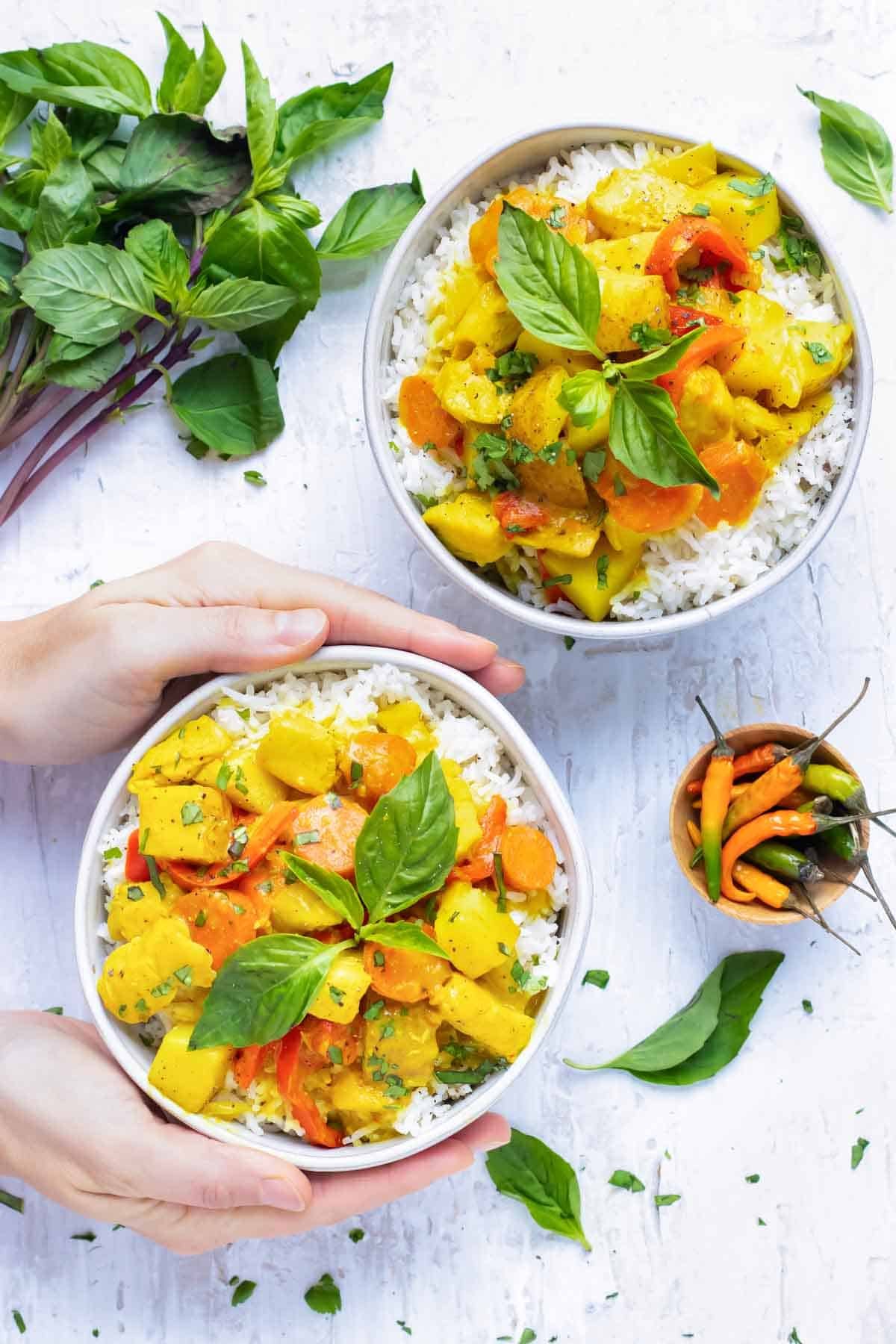
Other Thai-Inspired Dishes
Skip the take-out and whip up your own Thai dishes easily at home with any of these recipes.
- Thai Basil Chicken
- Easy Pad Thai
- Ground Chicken Thai Lettuce Wraps
- Thai Peanut Quinoa Salad
- Thai Chili Baked Wings
- Spaghetti Squash Pad Thai
- Asian Cucumber Salad
More Easy Curry Recipes
Curry is such a diverse dish that can be enjoyed in so many ways—yet somehow always manages to be perfectly warming and satisfying.
- Green Chicken Curry
- Massaman Curry.
- Chickpea Curry
- Slow Cooker Chicken Curry with Coconut Milk
- Chicken Korma Curry
- Instant Pot Yellow Chicken Curry
- Salmon Curry with Coconut Milk
- Curry Roasted Cauliflower with Yogurt Sauce
Tap stars to rate!
Thai Yellow Chicken Curry Recipe
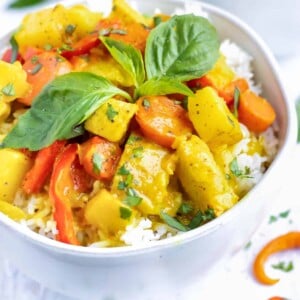
email this recipe!
Ingredients
Yellow Curry Paste
- 4 cloves garlic crushed
- 2 tsp. ginger paste or grated ginger
- 2-6 Thai chili peppers finely diced
- 1 ½ tsp. salt
- 1 Tbsp. turmeric
- 1 Tbsp. curry powder mild
- 1 tsp. coriander ground
- 1 Tbsp. lemongrass paste
- Or ⅓ cup of store-bought yellow curry paste
Yellow Chicken Curry
- 2 Tbsp. olive oil
- 1 ½ cups sweet onions cut into 1-inch pieces
- 1 lb. chicken cut into 1-inch cubes
- 1 red bell pepper cut into 2-inch strips
- 3 large carrots cut into ½-inch pieces, about 1 ½ cups
- 4 Yukon gold potatoes cut into ¾-inch cubes, about 1 ½ cups
- 2 15-oz. cans full-fat coconut milk or one can lite and one can full-fat
- 1 Tbsp. white sugar
- ½ tsp. salt
Instructions
- Make the Curry Paste: Combine all yellow curry paste ingredients together in the bowl of a small food processor. (If you have a 6+ cup processor you may want to double the recipe.) Process ingredients for 2-4 minutes, or until ingredients become a thick paste.4 cloves garlic, 2 tsp. ginger paste, 2-6 Thai chili peppers, 1 ½ tsp. salt, 1 Tbsp. turmeric, 1 Tbsp. curry powder, 1 tsp. coriander, 1 Tbsp. lemongrass paste, Or ⅓ cup of store-bought yellow curry paste
- Sauté the Meat and Veggies: Drizzle olive oil into a large pan over medium heat and add onions. Sauté for 3-5 minutes. Add chicken and curry paste. Sauté over medium heat for 3-5 more minutes, or until the chicken is almost done cooking. Add red bell peppers, carrots, potatoes, milk, sugar, and salt. Stir until well combined.2 Tbsp. olive oil, 1 ½ cups sweet onions, 1 lb. chicken, 1 red bell pepper, 3 large carrots, 4 Yukon gold potatoes, 2 15-oz. cans full-fat coconut milk, 1 Tbsp. white sugar, ½ tsp. salt
- Simmer and Serve: Bring curry to a boil and then reduce heat to a simmer. Cover and let simmer for 25-35 minutes or until potatoes and carrots are fork tender. Serve Thai yellow chicken curry over jasmine rice and enjoy!
Tap stars to rate!
Notes
- Change it up. While this is commonly served with chicken, opt for shrimp or pork for a different flavor. You can even go with a firm tofu!
- Up the benefits. Feel free to include additional vegetables, like snow peas, celery, broccoli, sweet potatoes, green beans, or even cabbage.
- Be fancy. Take some extra time to cut your veggies at a diagonal angle for a nice look.
- Go low-carb. Serve over a bed of cauliflower rice for extra nutrition.
- Some like it hot. Add in extra peppers or opt for a hotter variety to increase the spice level if you like a bit of heat.
Nutrition
Nutrition information is automatically calculated, so should only be used as an approximation.
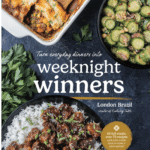
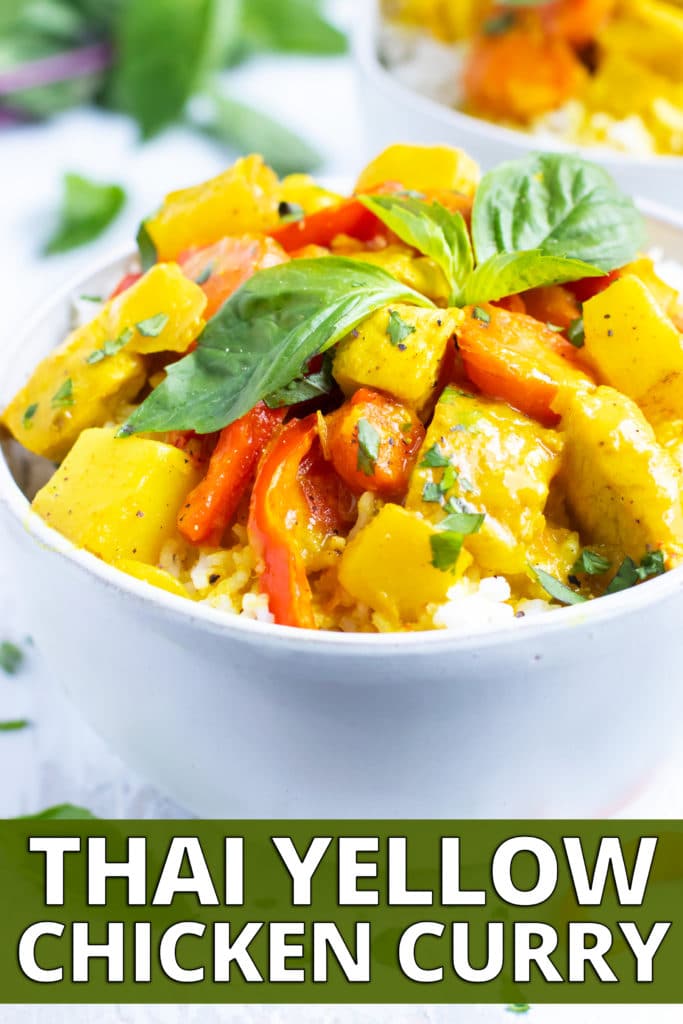
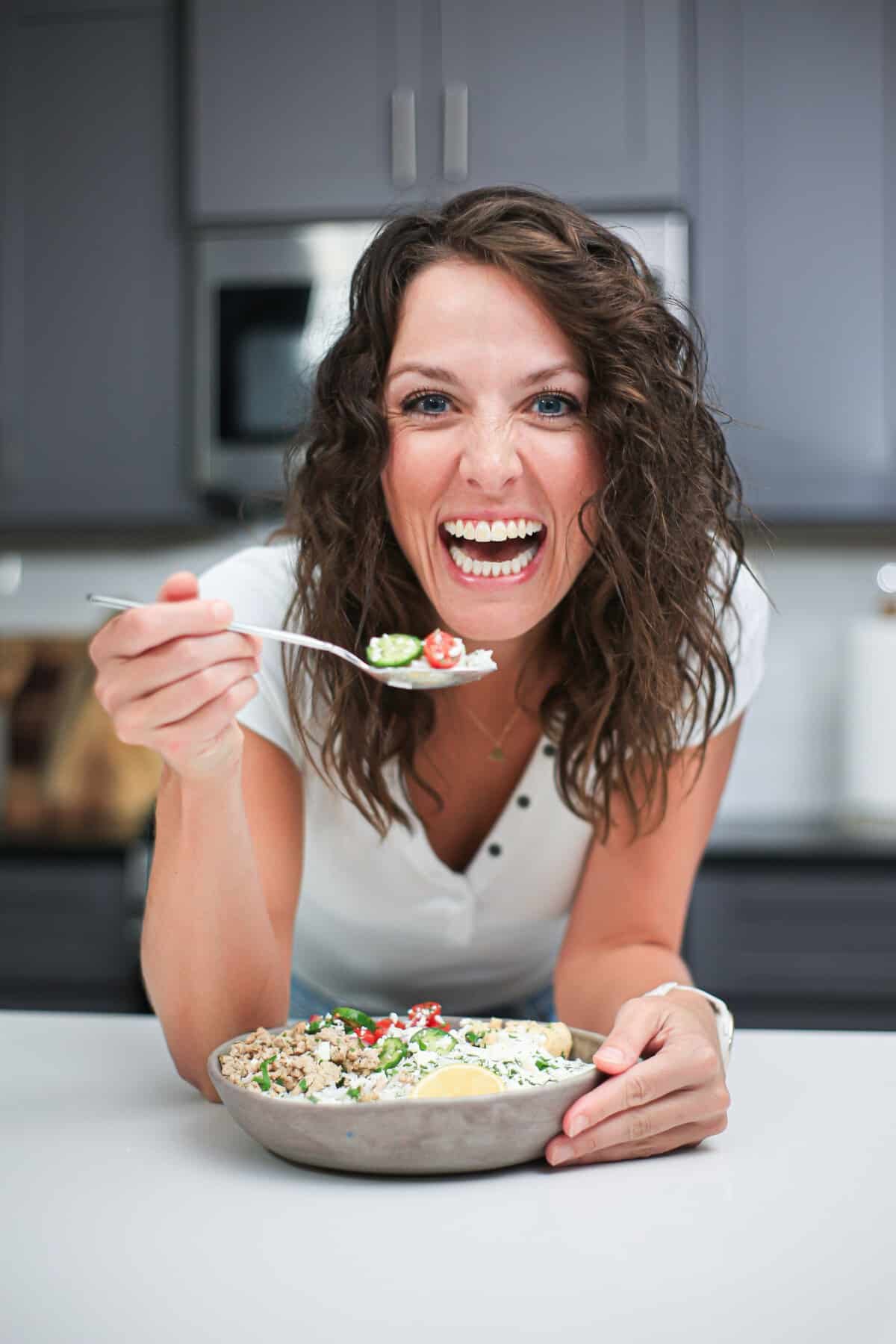

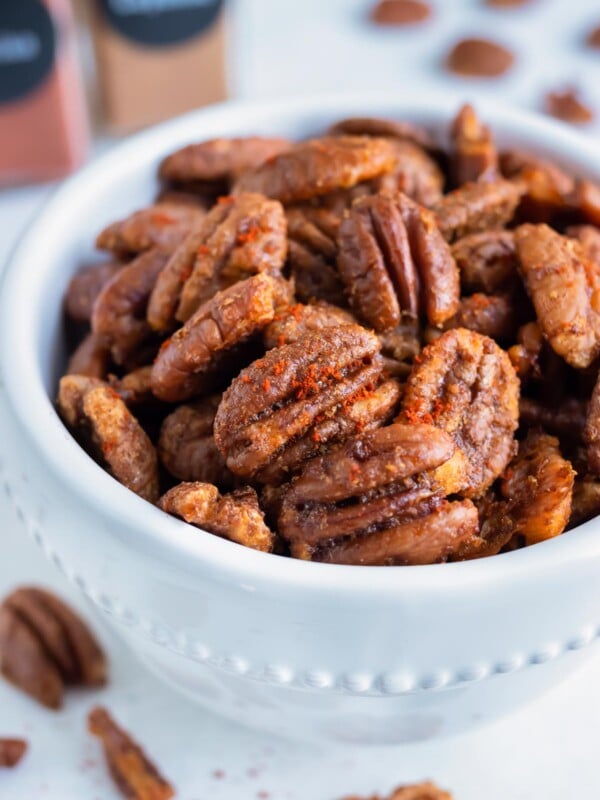











It would be nice to hear something about the hard to find lemon grass as an actual ingredient.
Hi Dirk! Lemongrass paste is a bit easier to find. You can also substitute a Thai Yellow curry paste for the homemade paste. This post will be updated soon to reflect these tips. Sorry for the confusion and hope this helps.